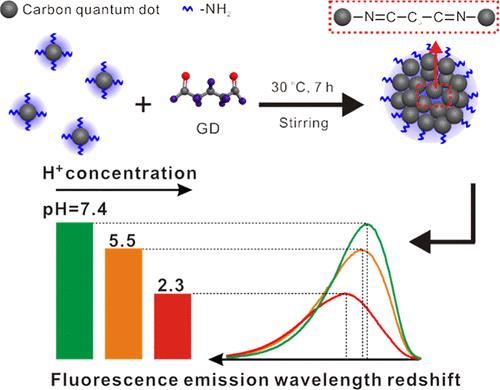共价偶联碳量子点实现光致发光红移对 pH 值的响应
IF 4.7
2区 化学
Q1 CHEMISTRY, INORGANIC & NUCLEAR
引用次数: 0
摘要
传统的荧光pH传感器尽管具有高灵敏度和快速响应,但由于其依赖于荧光强度变化而受到限制,阻碍了需要精确波长控制的应用。在这里,我们提出了一种基于交联碳量子点(CCL-CQDs)的pH传感策略,该策略在荧光发射波长中显示出显着的pH依赖红移。通过一步水热法合成了氨基和羧基功能化CQDs,并通过氨基与戊二醛的缩合反应组装成CCL-CQDs。CCL-CQDs具有良好的pH敏感性,其荧光发射波长随pH值的增加呈线性红移(从2.29增加到7.16)。机理探索结果表明,H+诱导CCL-CQD结构中C = N键的断裂,导致-COOH基团的形成和表面氧化碳含量的增加。这种增强的氧化产生了更多的表面缺陷,引发了与表面状态相关的荧光发射的波长偏移。本研究成功合成了具有优异荧光检测性能的ph敏感CCL-CQDs。本文章由计算机程序翻译,如有差异,请以英文原文为准。

Covalently Coupling Carbon Quantum Dots for Photoluminescence Red Shift Response to pH
Conventional fluorescent pH sensors, despite offering high sensitivity and rapid response, are limited by their reliance on fluorescence intensity changes, hindering applications requiring precise wavelength control. Here, we present a pH sensing strategy based on cross-linked carbon quantum dots (CCL-CQDs) displaying a remarkable pH-dependent red shift in the fluorescence emission wavelength. Amino- and carboxyl-functionalized CQDs were synthesized via a one-step hydrothermal method and further assembled into CCL-CQDs through the condensation reaction between amino groups and glutaraldehyde. The CCL-CQDs displayed excellent pH sensitivity, with their fluorescence emission wavelength exhibiting a linear red shift upon increasing pH (from 2.29 to 7.16). The results of mechanism exploration revealed that H+ induced the cleavage of C═N bonds in the CCL-CQD structure, leading to the formation of –COOH groups and increased surface-oxidized carbon content. This enhanced oxidation generated more surface defects, triggering a wavelength shift in surface-state-related fluorescence emission. This study demonstrates the successful synthesis of pH-sensitive CCL-CQDs with an excellent fluorescence detection performance.
求助全文
通过发布文献求助,成功后即可免费获取论文全文。
去求助
来源期刊

Inorganic Chemistry
化学-无机化学与核化学
CiteScore
7.60
自引率
13.00%
发文量
1960
审稿时长
1.9 months
期刊介绍:
Inorganic Chemistry publishes fundamental studies in all phases of inorganic chemistry. Coverage includes experimental and theoretical reports on quantitative studies of structure and thermodynamics, kinetics, mechanisms of inorganic reactions, bioinorganic chemistry, and relevant aspects of organometallic chemistry, solid-state phenomena, and chemical bonding theory. Emphasis is placed on the synthesis, structure, thermodynamics, reactivity, spectroscopy, and bonding properties of significant new and known compounds.
 求助内容:
求助内容: 应助结果提醒方式:
应助结果提醒方式:


